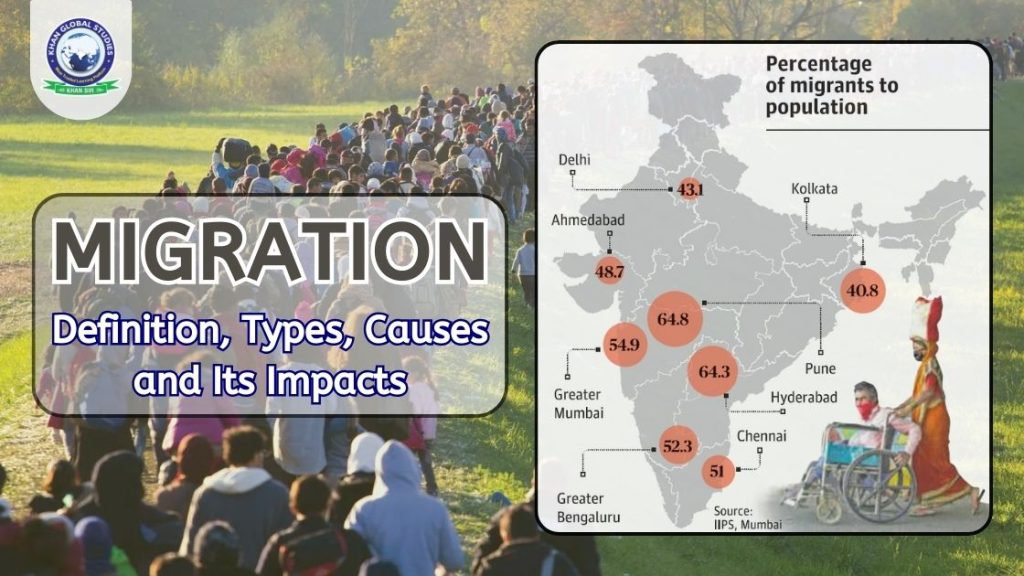Throughout history, human beings have been on the move. This movement across geographical boundaries, known as migration, shapes societies and economies both in the origin and destination countries. Understanding the definition, causes, and impacts of migration is crucial for addressing its complexities and navigating its consequences.
Migration is a way of moving from one place to another to live and work. It is the movement of people from their home to another city, state or country for a job, shelter or any other reason. Migration from rural areas to urban areas has increased in India in the last few years.
Definition of Migration
Migration refers to the long-term movement of individuals or groups from one place to another, intending to change their usual place of residence. This movement can be internal (within a country) or international (across borders). It can be temporary or permanent, voluntary or forced. Common types of migration include:
- Labour Migration: Movement for employment opportunities.
- Family Reunification: Joining family members residing in another location.
- Refugee Migration: Flight due to persecution or conflict.
- Environmental Migration: Displacement due to environmental factors like climate change.
Causes of Migration
Nowadays many people decide to migrate to get a better life. The most common reason for migration of people is employment opportunities. Furthermore, lack of opportunities, better education, construction of dams, globalization, natural disasters (floods and droughts) and sometimes crop failure forced villagers to migrate to cities. The push and pull factors motivate individuals to migrate.
Push factors compel people to leave their homes, often due to:
- Economic Hardship: Poverty, lack of jobs, or unequal opportunities.
- Political Instability: Conflict, persecution, or human rights violations.
- Environmental Degradation: Natural disasters, resource scarcity, or climate change.
Pull factors attract people to new destinations, often driven by:
- Economic Opportunities: Better job prospects, higher wages, or economic stability.
- Security and Peace: Seeking refuge from conflict or persecution.
- Family Reunification: Joining loved ones already living in the new location.
- Education and better Living Conditions: Pursuing higher education or improved quality of life.
Migrants
Those who move from one place to another in search of work or shelter are called migrants. Most of the time migrant people are not skilled or educated so they are usually employed as daily wage earners (workers who are paid at the end of each day for their services). Daily wage laborers do not get enough money to maintain their families and they face many problems like whether they have enough food to eat or not, cleanliness, hygiene, proper place to live etc. Not there.
Impacts of Migration
Migration is becoming a very important topic in the life of cities. The many opportunities and attractions of big cities attract a large number of people to big cities. Migration can have positive and negative effects on the lives of migrants.
Positive Impact
- Unemployment is reduced and people get better job opportunities.
- Migration helps improve the quality of life of people.
- It helps in improving the social life of people as they learn about new cultures, customs and languages which helps in improving brotherhood among the people.
- The migration of skilled workers leads to greater economic growth in the region.
- Children get better opportunities for higher education.
- Population density decreases and the birth rate decreases.
Negative Impact
- The departure of a person from rural areas affects the level of production and development of rural areas.
- The influx of workers into urban areas increases competition for jobs, homes, school facilities, etc.
- Having a large population puts a lot of pressure on natural resources, facilities and services.
- It is difficult for a villager to survive in urban areas because there is no natural environment and pure air in urban areas. They have to pay for everything.
- Due to migration the population of a place changes, hence the distribution of population in India is uneven.
- Many migrants are completely illiterate and uneducated, therefore, they are not only unqualified for most jobs but also lack basic knowledge and life skills.
- Poverty makes them unable to live a normal and healthy life.
- Children growing up in poverty do not have access to proper nutrition, education or health.
- Due to migration, slums increased in cities due to which many problems like uncleanliness, crime, pollution etc. increased.
- Sometimes migrants are exploited.
- Migration is one of the main reasons for the increasing nuclear family where children grow up without a wider family circle.
Navigating the Complexities
Managing migration effectively requires acknowledging its complexities and adopting comprehensive approaches:
- Addressing root causes: Investing in developing nations, promoting peace and stability, and combating climate change can reduce forced migration.
- Regulation and enforcement: Clear, well-managed migration policies can protect migrants’ rights and address irregular migration.
- Integration and inclusion: Investing in integration programs helps migrants contribute to their new communities.
Conclusion
Migration is a global phenomenon with significant social, economic, and political implications. By understanding its causes and impacts, we can effectively manage its challenges and harness its potential for positive change. Through collaborative efforts and responsible policies, we can create a world where migration benefits both individuals and societies as a whole.




